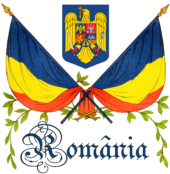- Symbols of Romania
-
This article is part of
Symbols of Romania seriesFlag of Romania · (history) · (list) Coat of arms of Romania Romanian Anthem Romanian heraldry Orders, decorations and medals Postage stamps of Romania Romanian leu Symbols of Romanian Royalty Symbols of Romania There are a number of national symbols of Romania, representing Romania or its people in either official or unofficial capacities.
List of national symbols
Official symbols
Type Image Symbol National flag 
The Flag of Romania
(Romanian: Drapelul României) is a tricolour with vertical stripes: beginning from the flagpole, blue, yellow and red, these colors found on late 16th century royal grants of Michael the Brave, as well as shields and banners representing Romanians everywhere. During the Wallachian uprising of 1821 these colors composed the revolutionaries’ flag and for the first time a recorded meaning was attributed to them: “Liberty (sky-blue), Justice (field yellow), Fraternity (blood red)”. The colors also symbolise the Principalities that formed Romania: Vallachia - yellow (having a yellow and blue flag prior to the 1859 Union), Moldavia - red (having a red and blue flag prior to the 1859 Union) and Transylvania -blue (having a blue-red-yellow flag prior to the 1918 Union)National Anthem
Awaken thee, Romanian!
Deşteaptă-te, române!
It was written and published during the 1848 revolution and was first sung in late June in the same year in the city of Brașov, being immediately accepted as the revolutionary anthem. Since then, this song, which contains a message of liberty and patriotism, has been sung during all major Romanian conflicts, including during the 1989 anti-Ceauşist revolution. In 1989 it became the national anthem, replacing the communist-era national anthem "Trei culori" ("Three colors"). The Moldavian Democratic Republic, during its brief existence, between 1917 and 1918 as well as the Republic of Moldova betweenn 1991 and 1994 had the same anthem. July 29 is the "National Anthem Day" (Ziua Imnului național), an annual observance in Romania.National coat of arms 
The Coat of arms of Romania
The golden aquila holding an Orthodox cross is the symbol of Latinity and a heraldic bird of the first order symboling courage. The shield on which it is placed is azure, symbolising the sky. The eagle holds in its talons the insignia of sovereignty: a mace and a sword, the latter reminding of Moldavia’s ruler, Stephen the Great whereas the mace reminds of Michael the Brave, the first unifier of the Romanian Principalities. On the bird’s chest there is a quartered escutcheon with the symbols of the historical Romanian provinces (Wallachia, Moldavia, Transylvania, Banat and Oltenia but also Dobrogea).Military Flag 
The Battle Colors of Romania
The military colors are the symbol of military honor, bravery and glory. They evoke the past struggle of the Romanian people for national liberty and the traditions of unity, reminding each soldier of his sacred duty to serve the Fatherland with trust, and to defend at all costs the unity, sovereignty and independence of RomaniaNational holiday 
Great Union Day
It commemorates the assembly of the delegates of the people of Transilvania held in Alba Iulia, which declared the Union of Transylvania with Romania. This holiday was set after the 1989 Romanian Revolution and it marks the unification of Transylvania, but also of the provinces of Bessarabia and Bukovina with the Romanian Kingdom, in 1918. Prior to 1918, the national holiday of Romania was set to be on May 10, which had a double meaning: it was the day on which Carol I of Romania set foot on the Romanian soil (in 1866), and it was the day on which the prince ratified the Declaration of Independence from the Ottoman Empire in 1877. In Communist Romania, the date of the national holiday was set to August 23 to mark the 1944 overthrow of the pro-fascist government of Marshal Ion Antonescu.Official language 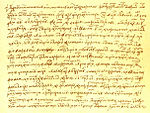
Romanian
The main Eastern Romance language, spoken by around 24 to 28 million peopleUnofficial symbols
Type Image Symbol National Crown 
The Steel Crown of Romania
The crown was forged from the steel of a gun captured by the Romanian Army from the Ottomans during the War of Independence (1877-1878). King Carol I of Romania chose steel, and not gold, to symbolize the bravery of the Romanian soldiers and was crown with it during the ceremonies of the proclamation of Romania as a kingdom in 1881 in Bucharest.The Crown was again used in 1922 at the coronation of King Ferdinand I of Romania and Queen Maria of Romania as sovereigns at Alba-Iulia. The third time the Crown was used during the coronation and anointment of King Michael I of Romania by the Orthodox Patriarch of Romania, Nicodim Munteanu, in the Patriarchal Cathedral of Bucharest, on the very day of his second accession, September 6, 1940. The Steel Crown is kept in the National Museum of Romanian HistoryNational patron saint 
Saint Andrew
Acording to the Romanian Orthodox Church, Andrew preached the Gospel to the Daco-Romans in the province of Dobrogea (Scythia Minor), whom he converted to Christianity. There are some archaeological evidences for this tradition found in a cave called Basarabi, near Constanţa harbour, containing carved symbols of ancient Christianity. The Romanians have never been recordedly converted to Christianity as the neighboring nations, instead adopting the Orthodox Faith by themselves during the ethnogenesis process in an unorganized fashion. Having Apostle Andrew as a patron saint marks a special connection with the Ecumenical Patriarchate of Constantinopole and the political and religious heritage of Byzantium in the Romanian Principalities, metaphorically called Byzantium after ByzantiumNational personification 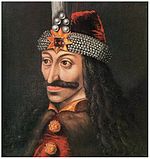
Dracula or Vlad the Impaler 
Revolutionary Romania National Motto 
"Nihil Sine Deo"
(Latin, "Nothing without God")
used under the Hohenzollern-Sigmaringen dinasty
"Toţi în unu"
(Romanian, "All in one")
used during the reign of Alexandru Ioan Cuza
"Dreptate, Frăţie"
(Romanian, "Justice, Brotherhood")
used during the 1848 revolutionNational Founders 
Decebal
His name meaning "The Brave", Decebal was the last king of Dacia between 87–106 AD and is famous for fighting three wars and negotiating two periods of peace against the Roman Empire under two emperors, during which he continued to act as an independent king, rather than a conquered client and repeatedly annoyed or infuriated the Romans. Consequently, the Legions under Trajan's orders went on the offensive again in 105 AD, taking the Dacian capital city of Sarmizegetusa in 106, leading Decebal to commit suicide.Decebal is considered a national hero in Romania, a symbol of the Dacian origins of the Romanian people.
Trajan
The Roman Emperor who conquered Dacia and brought the latin element that together with the Dacian autochtons created the Romanian people
Mihai Viteazul
During his reign, the principalities of Wallachia (1593–1601), Transylvania (1599–1600), and Moldavia (1600) forming the territory of present-day Romania and Republic of Moldova were ruled for the first time by a single Romanian leader. He is regarded as one of Romania's greatest national heroes.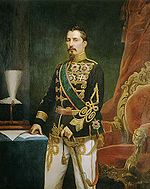
Alexandru Ioan Cuza 
Ferdinand of Romania Floral emblem 
Edelweiss 
Romanian Peony 
Dog Rose National animal 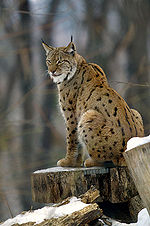
Lynx 
Dacian Draco 
Auroch (especialy in Moldavia) National bird 
Great White Pelican 
Golden Eagle (the Mountain Aquila) National Tree 
Oak National Poet 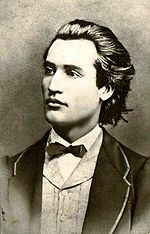
Mihai Eminescu National Epic 
Mioriţa National Hat 
Clop 
Cuşmă National Motif 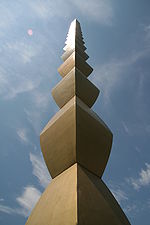
The Endless Column depicting an important motif in the traditional art. The pattern stands for infinity and persistence. National Art 
Carul cu Boi National Guard Regiment 
Regimentul 30 Gardă "Mihai Viteazul" National Building 
Palace of the Parliament National Mountain 
Bucegi, believed to be the Dacian holy mountain Kogainon, on which the mythical figure Zalmoxis resided in a cave, and also the location of the enigmatic natural formations called The Great Sphinx and Babele National Sport 
Oina National Dance 
Căluş National instrument 
Pan flute 
Tulnic National Liquor 
Pălincă 
Ţuică National Dish 
Bulz 
Mititei 
Borș, a sour soup made from fermented wheat bran especialy popular in Moldavia 
Fasole cu ciolan, a dish of beans and smoked meat served on the National Day of Romania National Sweet Cozonac Symbols of Europe Sovereign
statesAlbania · Andorra · Armenia · Austria · Azerbaijan · Belarus · Belgium · Bosnia and Herzegovina · Bulgaria · Croatia · Cyprus · Czech Republic · Denmark · Estonia · Finland · France · Georgia · Germany · Greece · Hungary · Iceland · Ireland · Italy · Kazakhstan · Latvia · Liechtenstein · Lithuania · Luxembourg · Macedonia · Malta · Moldova · Monaco · Montenegro · Netherlands · Norway · Poland · Portugal · Romania · Russia · San Marino · Serbia · Slovakia · Slovenia · Spain · Sweden · Switzerland · Turkey · Ukraine · United Kingdom (England • Northern Ireland • Scotland • Wales)
States with limited
recognitionAbkhazia · Kosovo · Nagorno-Karabakh · Northern Cyprus · South Ossetia · Transnistria
Dependencies
and other territoriesÅland · Faroe Islands · Gibraltar · Guernsey · Jan Mayen · Jersey · Isle of Man · Svalbard
Other entities European UnionCategories:- National symbols of Romania
Wikimedia Foundation. 2010.

